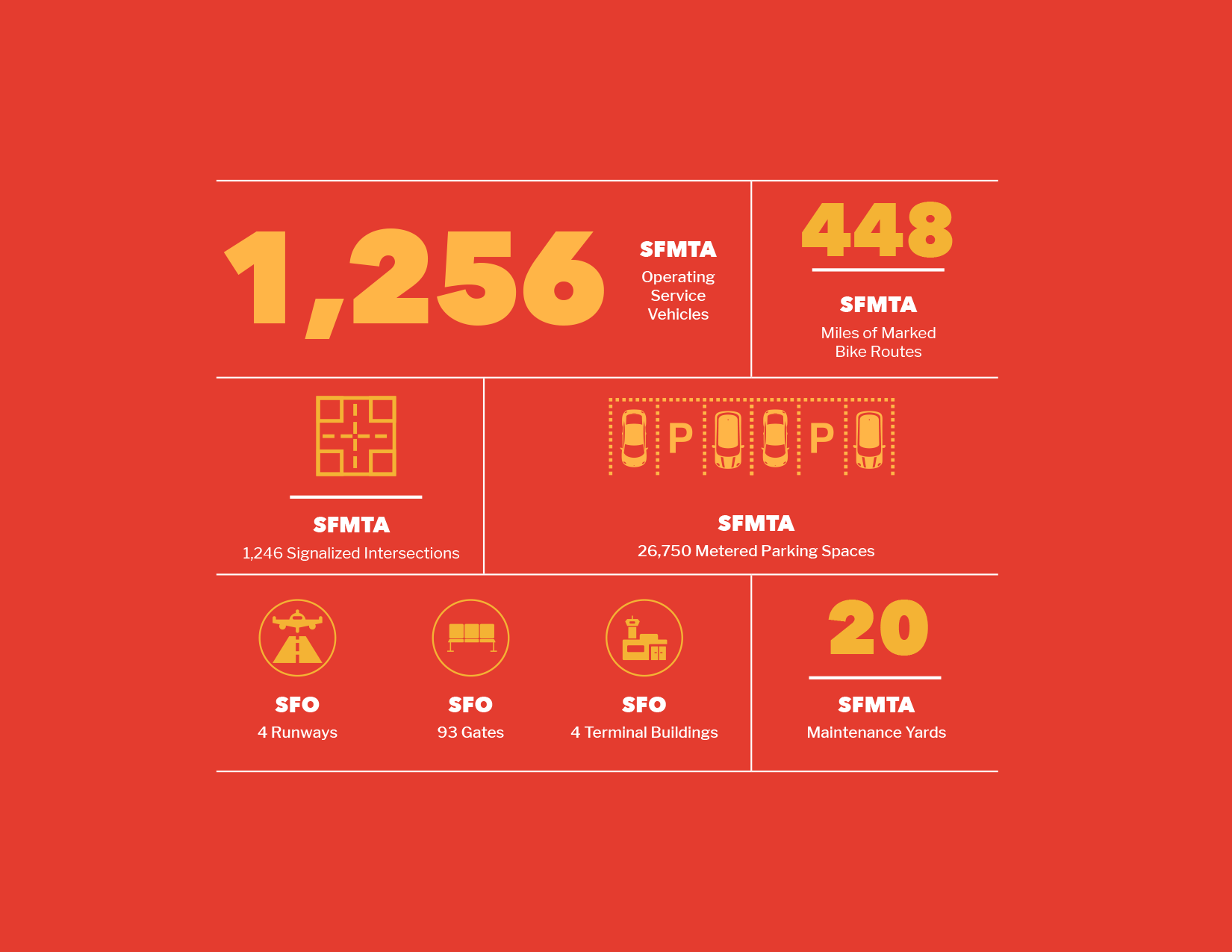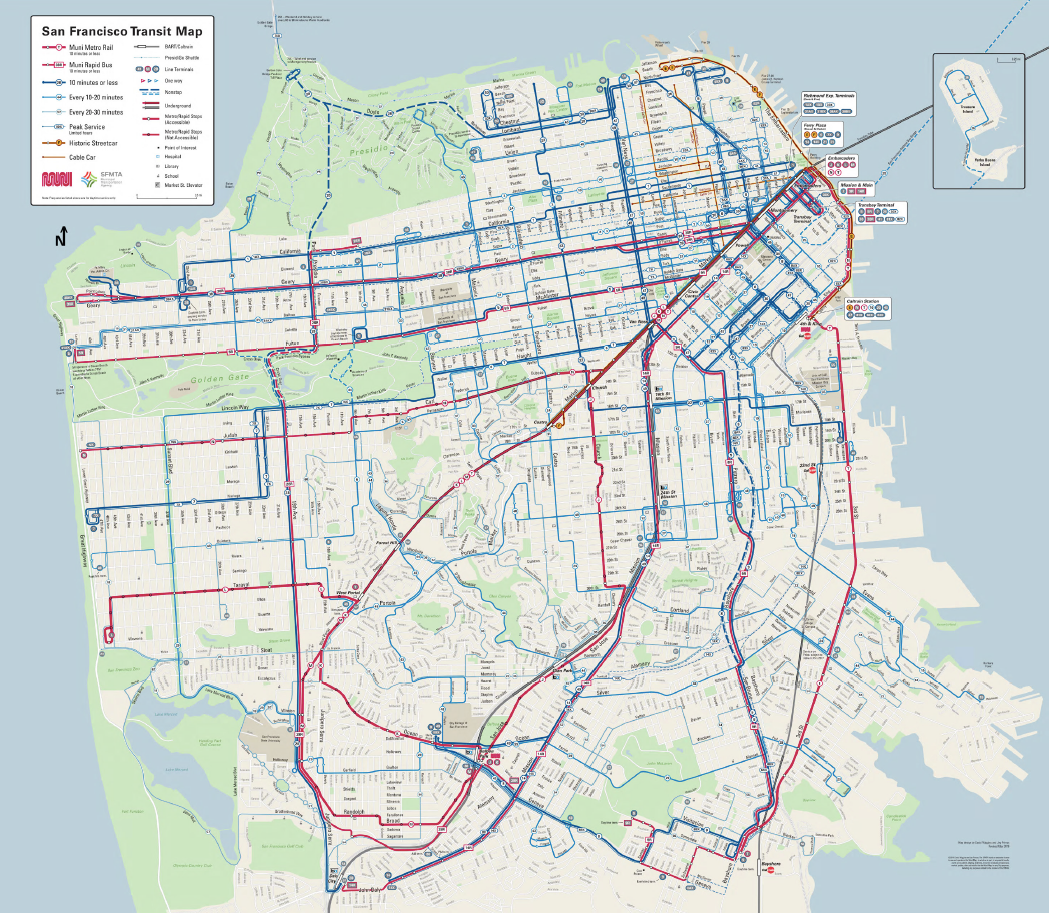SFO: San Francisco International Airport
PORT: Port of San Francisco
SFCTA: San Francisco County Transit Authority
Caltrain: Peninsula Corridor Joint Powers Board
TJPA: Transbay Joint Powers Authority
BART: Bay Area Rapid Transit
With San Francisco’s population and economy growing, the local transportation infrastructure has never been more important to the city’s well-being. Without smooth operations and adequate capacity, residents, workers, and visitors would be unable to access jobs, schools, or the cultural institutions that make San Francisco special. Transportation is also a driver of regional and national competitiveness, allowing San Francisco to propel innovation and attract tourism. It is critical that San Francisco take care of our transportation needs so that the city remains accessible and livable for generations to come. The myriad transportation offerings that run to and through San Francisco connect neighborhoods and ensure that the city is accessible to locals, commuters, and travelers alike. This chapter describes projects and programs that will improve San Francisco’s transportation network over the next 10 years.


San Francisco sits at the center of the Bay Area, both geographically and economically. To support residents, workers, and visitors, the City must maintain a vast system of transportation infrastructure ranging from cross-town buses and Muni trains to the San Francisco International Airport, one of the busiest in the United States. Regional transportation assets like BART and Caltrain also run through the city, connecting San Francisco to the surrounding counties.
San Francisco is currently in the midst of implementing several major initiatives that will improve its transportation system. From the Salesforce Transit Center downtown, bus rapid transit lines on major thoroughfares, and terminal expansions at the Airport, San Francisco is adding capacity that will dramatically improve mobility for residents. These projects will expand the transit network and provide benefits throughout the city.
San Francisco Municipal Transportation Agency
The San Francisco Municipal Transportation Agency manages all City-owned ground transportation infrastructure. Related operations include running the San Francisco Municipal Railway (Muni), managing parking and traffic, facilitating bicycling and walking, regulating taxis, and delivering community-based projects to improve the transportation network and prepare for the future.
The SFMTA has a number of short-term and long-term processes in place to identify and prioritize its capital projects. Once every two years the SFMTA develops its own fiscally unconstrained Capital Plan, last published in 2017, to identify needs for projects and programs over the next 20 years. The SFMTA Capital Plan is overseen by the Transportation Capital Committee, which is comprised of representatives from all the agency’s functional divisions. This identifies the agency’s capital investment needs and establishes priority investments.
Over the next 10 years, the SFMTA’s planned capital projects total $4.9 billion. Even with that substantial planned investment, approximately $4.6 billion in need is deferred.
This City-wide Capital Plan summarizes SFMTA’s capital needs at a high level. For a detailed description of SFMTA’s capital projects, please see the SFMTA’s published plans at https://www.sfmta.com/reports-documents.
San Francisco International Airport
Owned by the City and County of San Francisco, and located within unincorporated San Mateo County, the San Francisco International Airport manages a large and diverse infrastructure portfolio that includes four runways, 91 operational gates, and four terminals that total 4.4 million square feet. It also oversees 32 miles of roadways, five parking garages, the AirTrain transit system, a rental car facility, leased cargo and maintenance facilities, a waste treatment plant, and more than 274 miles of pipelines, ducts, power, and pump stations for water, sewage, storm drainage,
industrial waste, and gas, in addition to electrical and telecommunications distribution systems.
To help manage its assets, the Airport maintains a five-year and a 10-year Capital Plan, which are generally updated annually. A major objective of Airport’s current Capital Plan is to meet increased infrastructure demands driven by historic levels of passenger growth. In FY2018 the Airport continued its long run of passenger growth, reaching a record 57.8 million passengers – a 7.2% increase over the prior year and a 58% increase since FY2009.
The Airport’s Capital Plan identifies $2.9 billion in planned infrastructure projects through FY2029. This chapter contains a high-level summary of the Airport’s capital programs. For a more in-depth description of the Airport’s capital projects, please see the five-year and 10-year Capital Plans published on the Airport’s website: http://www.flysfo.com/about-sfo.
Port of San Francisco
The Port of San Francisco is the hub of the local and regional commuter, special event, and tourist water transportation network in the Bay Area. The Port constructs and provides land and water areas to support ferries and excursion vessels that are operated by external agencies such as the Water Emergency Transit Agency (WETA) and the Golden Gate Bridge and Ferry District. Though it does not operate any vessels itself, the Port works in close collaboration with these critical agencies. The expansion of both publicly and privately operated ferries has helped to address congestion in the Bay Area while continuing to build an emergency response network. WETA ridership has grown by 78% since 2012 and is expected to continue to grow in the coming years.
San Francisco County Transportation Authority
The San Francisco County Transportation Authority is the sub-regional transportation planning and programming agency for the City. The SFCTA is responsible for the City’s long-range transportation planning, coordinating with federal, state, and other local transportation agencies. In this capacity, SFCTA helps to plan, fund, and deliver improvements for San Francisco's roadway and public transportation networks. The SFCTA is funded through a combination of local funds including San Francisco Sales Tax revenues and Vehicle Registration Fees, as well as grants from the State of California and federal government.
Peninsula Corridor Joint Powers Board (Caltrain)
San Francisco, along with San Mateo and Santa Clara counties, is a representative member of the Peninsula Corridor Joint Powers Board (JPB), which operates and maintains Caltrain, one of the oldest commuter rail services in Northern California. Caltrain provides peak and off-peak connections along the Peninsula rail corridor between San Francisco and Gilroy. Per the 1996 Joint Powers Agreement, funding for system-wide capital improvements are shared equally among the three member counties, while local improvements are, in general, borne by the county in which the improvements are located. More information on the JPB’s future projects and programs can be found at http://www.caltrain.com/projectsplans.html.
Transbay Joint Powers Authority
The Transbay Joint Powers Authority was created to manage the financing, design, development, construction, and operation of the Transbay Program, including the Salesforce Transit Center and the Caltrain Downtown Extension (DTX). Phase One of the Transbay Program includes constructing the Salesforce Transit Center, a $2.3 billion modern transit hub that replaces the seismically deficient terminal in downtown San Francisco. When completed, the Salesforce Transit Center will help unify a fractured regional transportation network by connecting eight Bay Area counties and the State of California through 11 transit systems: AC Transit, BART, Caltrain, Golden Gate Transit, Greyhound, Muni, SamTrans, WestCAT Lynx, Amtrak, Paratransit, and the future California High-Speed Rail. The project is split in two phases. Phase 1 saw the opening of the Salesforce Transit Center in August 2018; Phase 2 encompasses construction of the Caltrain Downtown Extension, a new Fourth and Townsend Street Caltrain station, the Transit Center’s train station and pedestrian connection to BART and Muni, and a new intercity bus facility.
A related effort overseen by San Francisco’s Office of Community Investment and Infrastructure will create a new mixed-use transit-oriented neighborhood surrounding the Transit Center. For more information on this neighborhood development, please refer to the Office of Community Infrastructure and Investment Section in the Economic and Neighborhood Development chapter of this Plan.
Bay Area Rapid Transit
Since its opening in 1972, Bay Area Rapid Transit has become essential to the mobility, economy, and livability of the Bay Area for riders and non-riders alike. BART currently carries 440,000 passengers on a typical weekday. Forecasts suggest that demand for BART will increase as the region grows, with 600,000 daily riders projected to use BART by 2040. However, after 46 years of service, BART faces major challenges including aging infrastructure and crowded conditions for riders.
BART improvements within San Francisco will include repairing water damage in the Market Street tunnels, ADA compliance to improve accessibility, station modernizations, escalator replacements, and adding protective canopies downtown.

